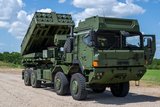US Army awards Lockheed Martin $445m GMLRS contract
Lockheed Martin has received a $445 million follow-on contract for Guided Multiple Launch Rocket System (MLRS) Unitary rockets from the US Army Aviation & Missile Command. This is the US Army's sixth purchase of the precision munition, with almost 2,000 GMLRS rockets fired in support of US and allied military operations to date.
The contract includes 735 GMLRS Unitary rocket pods (six rockets per pod) and 508 Reduced-Range Practice Rocket pods for the US Army and US Marine Corps, as well as GMLRS pods for Foreign Military Sales (FMS) customers including Japan, Jordan, Singapore and the United Arab Emirates. Specific numbers of rocket pods for the FMS customers were not disclosed. Work on the contract will be performed at the company's facilities in Camden, Ark., and Dallas,Texas. Deliveries are scheduled to begin in December 2012.
"Our enemies fear the precision that GMLRS delivers," said Lt. Col. Drew Clanton, the GMLRS Product Manager at the US Army's Precision Fires, Rockets and Missiles program management office in Huntsville, Ala. "US forces can increase their standoff distances without losing accuracy, which is paramount to our efforts to destroy threats while limiting collateral damage."
GMLRS provides dependable precision strike, a capability demonstrated currently in Afghanistan, and continues to exceed operational-readiness requirements.
"GMLRS continues to be one of the most powerful and precise assets for artillery today," said Scott Arnold, vice president for Precision Fires at Lockheed Martin Missiles and Fire Control. "Its heavy use in combat shows our customers trust GMLRS because it's reliable and delivers incredible precision, enabling faster and more effective missions."
The GMLRS Unitary rocket is successfully meeting the needs of the US Army, US Marine Corps and British Army artillery units in theater. The program also is looking ahead to meet evolving customer requirements by testing new technology in their IRAD-funded GMLRS+ program, which will integrate advanced capabilities that will keep GMLRS the world's premier long-range precision artillery rocket.
Designed specifically for destroying high-priority targets at ranges up to 70 kilometers, GMLRS has been employed in both urban and non-urban environments. It is an all-weather, rapidly deployable, long-range rocket that delivers precision strike beyond the range of most conventional weapons. Each GMLRS missile is packaged in a MLRS launch pod and is fired from the MLRS Family of Launchers.
Source: Lockheed Martin
More from Land Warfare
-
![Lithuanian 1st Division to achieve initial operating capability in 2026]()
Lithuanian 1st Division to achieve initial operating capability in 2026
Lithuania is one of the countries stepping up its defences in the face of the war in Ukraine with a particular focus on its neighbour and Russian ally Belarus, which has been making incursions into Lithuania’s airspace with balloons and drones.
-
Medium knocked out of British Army LMP, with CAVS as heavyweight champion
As the British Army seeks to modernise and consolidate its diverse vehicle fleet, yet another change in direction is underway.
-
![Energy evolution: How laser defence systems are powering the next phase of air defence (podcast)]()
Energy evolution: How laser defence systems are powering the next phase of air defence (podcast)
Laser-based air defence is moving from promise to deployment as global threats evolve. In this special podcast, we explore how high-energy laser systems are reshaping interception strategies.
























